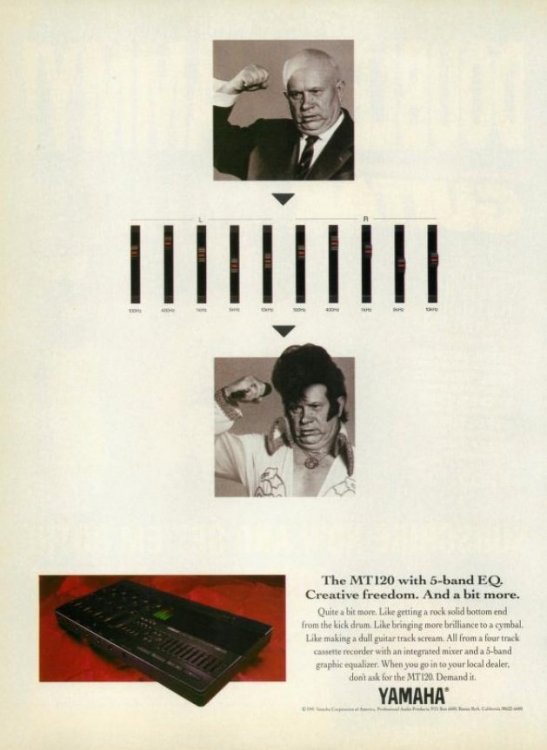Топ потребители
Най харесвано
Showing content with the highest reputation on 03/14/21 във всички области
-
2 points
-
Класическа китара с найлонови струни е различен вид китара от акустичната (уестърн/каубойска) китара с метални струни. На класическата китара се слагат задължително само найлонови струни, тези които казваш, че са метални, те също са найлонови, но с метална намотка (покритие) отгоре, те са басовите стрини. Оставаш си китарата така, както е и така се учиш. Струно се сменят, когато почнат да ти звучат глухо, т.е. може да караш няколко месеца здраво свирене, ще усетиш кога, басовите потъмняват, износват се. Като отидеш в магазна за нови струни казвая, искам комплект за акустична китара с нормален опън. Като решиш, че ти се свири и понаучиш нещо на китарата, която имаш, си вземи и акустична китара тип уестърн с метални струни. После електрическа и тн... So, you have decided to start playing the guitar! First of all, congratulations, you are about to embark on a rewarding musical journey that will undoubtedly change your life for the better – yes, guitar is that good! The journey begins by deciding what type of guitar you want to start with though, a tough decision! Of course, you can start with any type of guitar, whether electric, acoustic, classical, or bass, and once you have learned the basics you can swap between all of them at your own pace. Today we are going to focus on the most common starting points for guitarists; acoustic and classical guitars. Why classical vs acoustic guitar? If you want to know why most guitarists start on an acoustic or classical guitar, it’s usually because an acoustic is a little less harsh on the fingers and a very simple pick-up-and-play option. You don’t need an amplifier to hear the sound properly and they are often available at a lower price than electric guitars. For now, it is all about classical vs. acoustic guitars, as we discuss the differences to give you a better idea of what type of guitar might be right for you. Key Differences Between Classical and Acoustic Guitars 1. Fretboard The fretboard of a classical guitar is a lot wider than that of an acoustic. Quite often classical guitars will not have the fret markers (dots or inlays) along the fingerboard either. 2. Body Shape The shape is very different too. Acoustic guitars predominantly come in a dreadnought shape which is considerably larger than that of a classical guitar and cutaways where you have access to the higher frets on classical guitars are rather rare. 3. Price Often classical guitars are a little cheaper than their acoustic cousins, which is why many beginners start with a classical guitar first. 4. Strings Firstly, let’s clear up one thing – both these guitars are in fact acoustic guitars, except one uses nylon strings (classical) and the other uses steel string (acoustic). Confusing, yes but the differences between the two are vast! A classical guitar uses nylon strings whereas the modern acoustic uses steel string, hence it’s often referred to as a “steel string acoustic”. These strings both sound and feel very different indeed. The nylon strings of a classical guitar are a lot thicker and mellower or softer sounding than those of a steel string. With steel-string acoustic guitar strings you get a very twangy and bright sound that resonates (lasts longer) than a classical guitar. They also feel very different too. Nylon strings are thicker and because the treble strings (G,B, high E) are nylon and the bass strings are nylon cores with metal or use a nylon winding technique on the E, A, D strings, it can be a lot more comfortable to play when you’re a beginner. Steel-string acoustic guitars use a variety of metals for strings, including nickel and bronze and they are closer to the likes of electric guitar strings i.e., thinner and somewhat sharper on fingers. Do not worry though, with enough practice your fingers won’t hurt as much. 5. Timbre (Sound) The difference in strings and shape plays a huge part in how the two guitars sound which will also be a deciding factor when it comes to choosing one over the other. Think about what type of music you prefer to listen to. If you like Gypsy Kings-style music, Flamenco or Spanish guitar, the classical guitar is right for you and often the main, if not only, type of guitar those types of musician’s use. Pretty much every favourite band of yours will be using a steel-string acoustic rather than a classical guitar. Yes, you can learn on either one, but “Wonderwall” by Oasis or “Yesterday” by The Beatles will sound very weird indeed when played with a classical guitar. Most guitarists will make the natural progression from classical to acoustic, but very few choose to stay loyal to a classical guitar. So, which one is the right guitar for me? Classical Nylon String Guitars If you like the sounds of Flamenco or Spanish guitar, want a cheaper alternative to learn the basics with or a lighter option that is slightly easier to carry, the classical guitar might be for you. Here are some affordable nylon string classical guitar options in price ascending order, ranging from quality beginner guitars to a more intermediate option for those who want to continue their journey with the classical guitar. If you don’t want to spend a great deal on a beginner guitar, the Redwood CG-212 Half-Size Classical Guitar is perfect for you. The mixture of solid hardwood body and nylon strings creates hearty energy paired with comfortable playability. The shorter scale is ideal for new players who are honing their technique before moving onto a three-quarter or full-scale model. The Yamaha C40 Classical Guitar is designed with beginners and students in mind, creating the perfect instrument on which to build up playing technique in comfort. As we have come to expect from the experts at Yamaha, the C40 is built to a high standard of quality and comes at a very affordable price. The Yamaha C40 features a spruce soundboard, which benefits from the tonewoods ability to resonate with ease and projects the timbre of the instrument beautifully. Fingerpicked notes ring out with the utmost clarity, guaranteeing an understated yet vibrant dynamic range. The back and sides are crafted using meranti, which produces a robust mid-range that is infused with warmth and depth. The combination of the tonewoods gives the Yamaha C40 a well-balanced timbre that is perfect for accessing a wide range of tones. Steel String Acoustic Guitars As for steel-string acoustic guitars, we’ve rounded up a couple of options, again ranging from beginner to those who want to get a bit more serious. If you like loud, rich tones and an extremely versatile option that you can use for a wide range of music genres, then you'll probably want to start with a steel string. Our first option comes from another trusted name in acoustic guitars comes in the form of Yamaha. The brand has been making guitars for musicians of all levels for decades and you can’t really go wrong with the Yamaha F310. A great quality instrument that you won’t have to upgrade (unless you really want to) due to the strong focus on playability and expert craftsmanship. Fender's well-stocked acoustic range does not disappoint. For those who have decided that the acoustic guitar is for them, you can’t go wrong with the Fender CD-60SCE. The solid dreadnought body produces the warmest of tones, whilst the stable neck offers fantastic playing support to lay your chops down on. Not only that but the cutaway allows you to reach the upper frets with greater ease. The Fender CD-60SCE is also an electro-acoustic (as the E in the name denotes). Therefore, it features a built-in pickup and preamp, which allows the guitar to be amplified for those times when you're taking to the stage or want to record directly into a mixing console or audio interface into your DAW of choice. Very useful indeed. Final Thought The best thing you can do is try as many guitars as you can and see which style is best for you and the music you like to play. There are thousands of guitars out there, but only a handful are right for you - take your time and have fun!1 point
-
Развинтих ги, сега има три дупки отгоре Майтапът настрана, винтовете са за монтиране на педалборд - идва с картонен шаблон къде да играе дрелката. Моят има скоби отдолу за целта така че минах и без дупчене, но по-компактните не винаги имат готово решение.1 point



